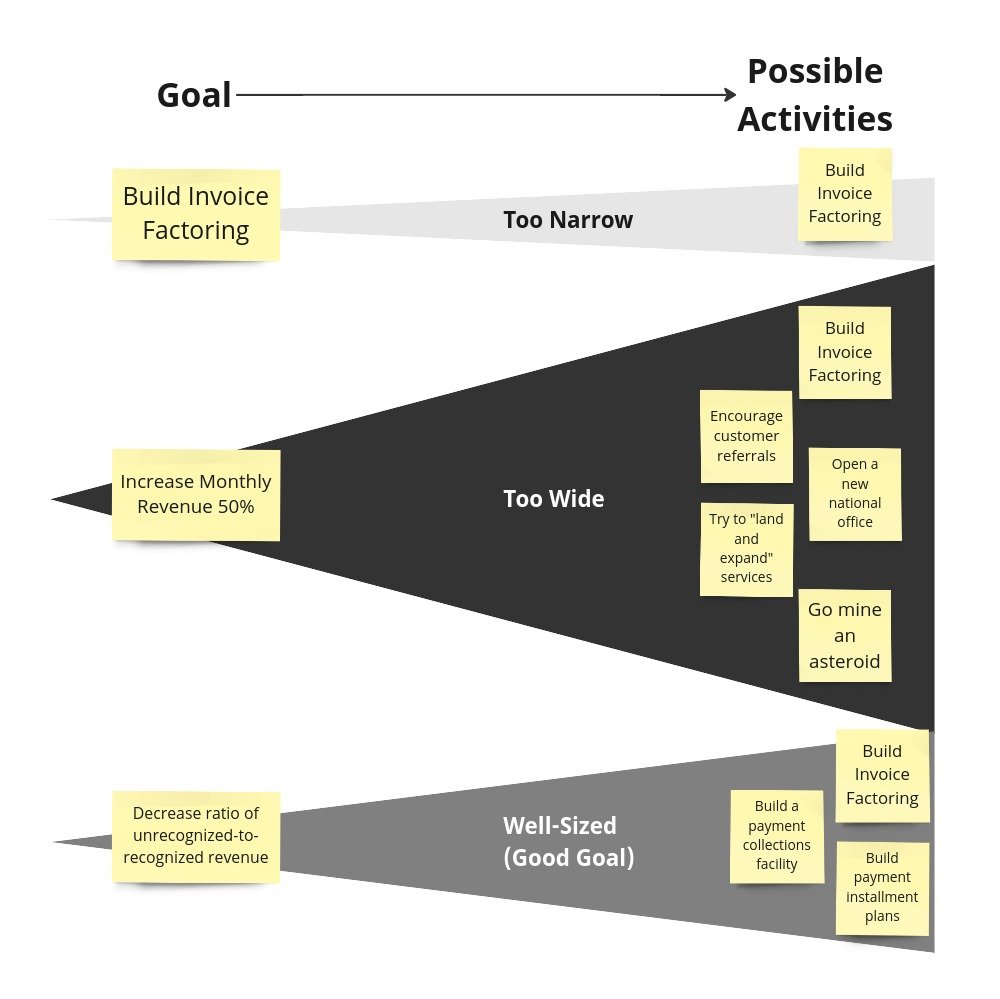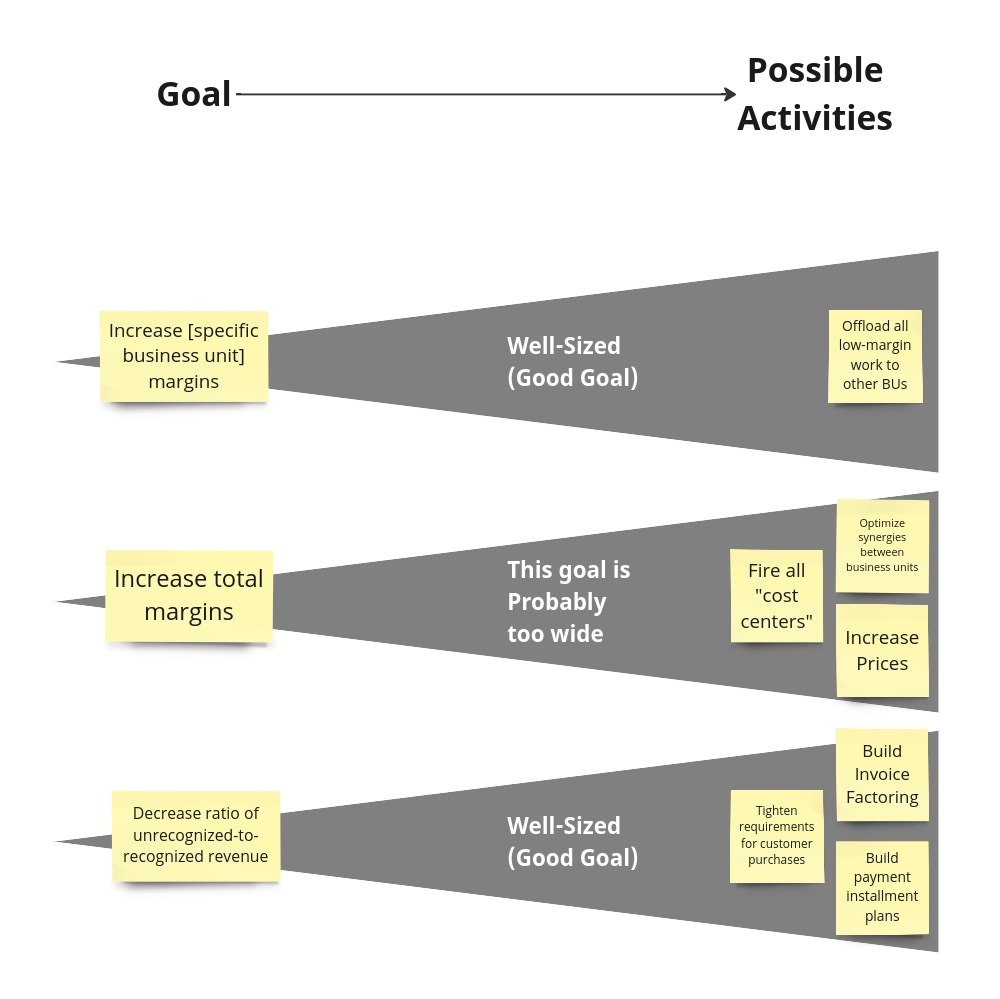Right-sizing a goal
Picking a goal for your team is something that sounds easy on the surface but it is full of nuance and challenges in communicating what exactly “the right goal” should be. To be clear, goals should not be To-Do-tasks (“build this feature”) or activities (“work on calling more customers”). They should also not be nebulous feel-good statements (“increase profits”). Most of all, we shouldn’t set goals based on what our job functions are but rather what our efforts contribute towards. Great goals are usually found somewhere in-between too-narrow and too-wide, as well as framed in a way that they don’t really care what your job is. if you’ve never done it before it can be really hard to find the sweet spot or wrap your mind around the fact that a goal is not the same as the thing as being 100% busy with a task you are skilled at.
Good goals are important (in contrast with the less useful “bad goals”). They unlock a key component of good strategy: allowing multiple people to make an impact in the same area. They also allow us to do something that we’re always told we should do: say no to stuff. Two core causes of being over-worked (and therefore unproductive, inefficient, producing poor quality work) is either having bad goals that are so wide the whole world fits inside (so you can never say “no”, and all effort gets smeared so thinly that there is no noticeable business impact anywhere), or goals that are so narrowly defined there’s no room to look for other paths to reach the goal or make an impact. Lastly, good goals allow us to say “yes” to things that actually matter. Teams frequently run into problems executing because things get lost in the “gaps” between job functions. The busier everyone gets because of bad goals, the higher everyone builds walls around themselves (“that’s not my job“), the more heavy-handed handovers happen, the more cycle times increase before handing over work to the next job function. Bad goals erode agility form the inside out.
Goals can translate into activities, and the way we scope a goal determines what activities are possible. Too narrow and your goal is just a task in disguise, too broad and everyone runs in any direction they want.
One major trap with bad goals is treating a bunch of too-narrow-goals (which are just tasks) as if they are goals, and then converting that to a long list of “goals” (they’re not goals, they’re tasks). First, this increases the surface-area of activities which drags apart team focus, and secondly, this becomes a set of “do or die” tasks with no room for autonomy or ways to be creative about finding the goal. You are trapped micromanaging a team (which is something you don’t have time for) that doesn’t really know what they’re doing (and you don’t have time to explain it because you’re busy micromanaging their tasks). Worse, there’s no possible way you can scale your knowledge and attention to both the breadth and depth of knowledge needed to define solutions really well, so either you’ll just pick a few favourites and everything else will burn, or you’ll stay at a high-level and be trapped wondering why your teams can’t deliver outcomes.
It looks something like this:
Goals should create some possibility of different activities in a narrow enough slice that we have freedom to move but still make impact in the desired place. Even when we get the scope of a goal right, we need to be careful of yet another trap: goals that have nothing to do with each other, or worse: goals that work against each other.
Imagine a scenario where the company sets 3 goals like this:
Focusing activities to only one goal without considering the others creates problems for us. Remember, a stand-alone goal as simple as “just make paperclips” (see Universal Paperclips) will eventually turn the entire universe into paperclips. In our case, we’ll run into a bunch of uncoordinated actions that makes everyone stuck: Can’t build anything for goal #3 because the dev team was fired as part of goal #2, and we can’t reach goal #2 because people are trying to make their internal BUs look great to reach goal #1.
This is especially tricky because “Increase each BU’s margin so we can increase total margins“ sounds like it ought to work, and people often don’t look at the details of what that really means. It’s important that the work you do in pursuit of a goal considers all the goals cohesively and not as stand-alone islands. The actions they result in should support one-another (or be neutral at worst).
When we overlay the possible activities we can see which activities end up being isolated and which ones support everything.
This view on the space lets people really understand if their goals are micro-optimizations that work against the whole, or if they really do push some part of the business forward in the desired direction.
So if in your day-to-day work it looks like everyone is really busy, and you hear a lot of “that’s not my job”, or fear that things can change at any moment, see heavy handovers between job functions (instead of working as a cross-functional team)… chances are, you should take a second pass at how your company handles goals.
One final but critical note: we need to actually be held accountable to our goals, otherwise they're just decorative things to bury in a slide deck somewhere, and a massive waste of everyone’s time. Good goals get used every week to make countless small decisions.




